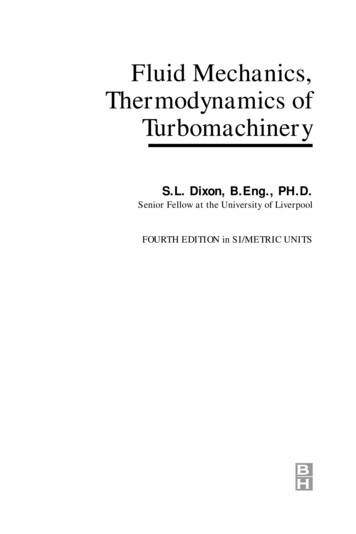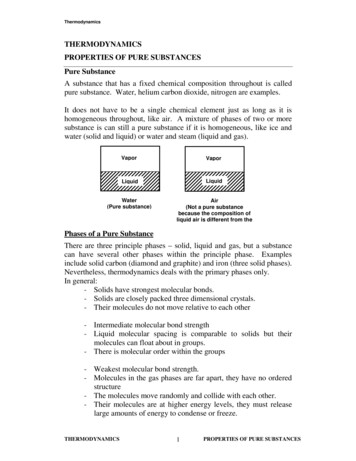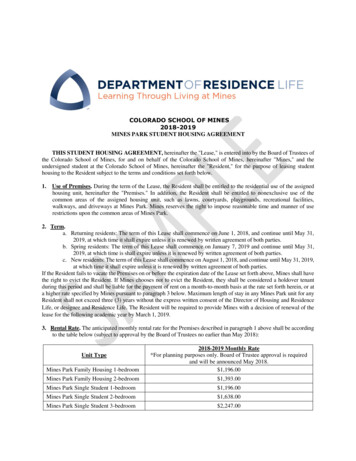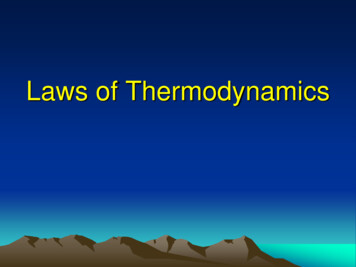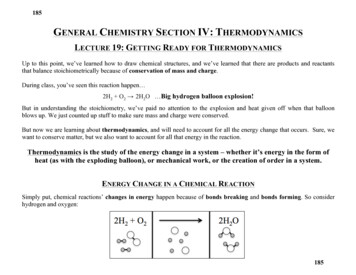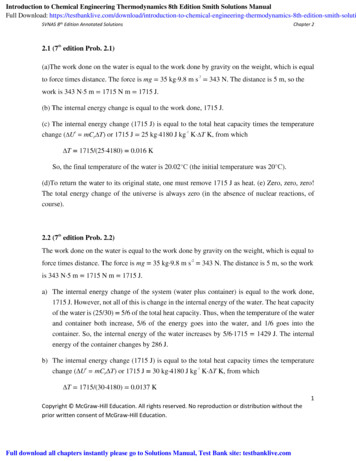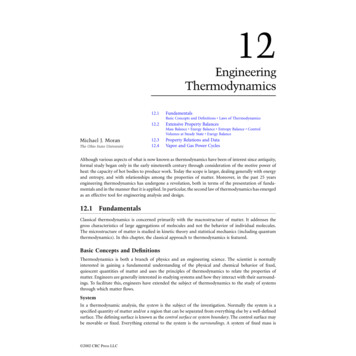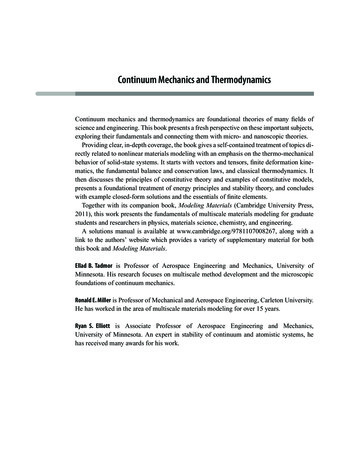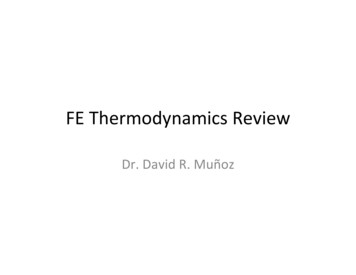
Transcription
FE Thermodynamics ReviewDr. David R. Muñoz
Definitions System – collection of matter which we areinterested in studying. Surroundings – everything outside of the system. Universe – system surroundings. Pure substance – its chemical compositionremains the same regardless of phase. Intensive property – thermodynamic propertyindependent of the system mass. Independent property – a stand alone propertythat can be used to identify the state of a system.
Definitions (cont.) State postulate for a pure substance – takes twoindependent intensive properties to fix its state. Closed system – mass does not cross the systemboundaries, but heat and work can cross thesystem boundaries Open system – mass crosses the systemboundaries, heat and work can also cross thesystem boundaries‐ Steady flow – open system with no massaccumulation‐ Unsteady flow ‐ open system with massaccumulation Sign convention: Heat into system is positive.Work out of system is positive.
General Exam Taking Philosophy You should prepare and work to get thecorrect answer whenever possible. However, on those problems you get stuck on,remember that wrong answers are no worsethan no answer. Therefore, first try to eliminate unreasonableanswers to improve the odds of guessingright. Then make your best guess. If you don’t have time to eliminate wronganswers, pick your favorite letter and guess.
Problem 1. What is the mass of air contained in a room20m x 40m x 3m at standard conditions? Standard conditions may vary depending on whatorganization is defining them. It is generally, P 1 atm 101 kPa at sea level, T 25oC 298K Assume: air is an ideal gas You are given the universal gas constant asRu 8.314 kJ/kmol K, where R Ru /M,M molecular weight for the particular gas ofinterest.
Problem 1 (cont.)Ideal gas Law: PV mRTm PV/RTR [8.314 kJ/kmol K]/[29 kg/kmol] 0.287 kJ/kg KV [20 x 40 x 3] m3 2400 m3Therefore,m [(101)kPa (2400)m3]/[(0.287)kJ/kg K (298)K]m 2834 kg
Problem 2 – Find the volume occupied by 20 kgof steam at 0.4 MPa, 400oC Use steam tables provided in your FE booklet At this point you do not know whether to usethe saturated mixture table or thesuperheated steam table, so that must first bedetermined. Recall the vapor dome associated with thesaturation conditions for water (see nextslide)
Temperature vs. volume andPressure vs. volume diagramsP
Saturation TableProblem 2 (cont.)‐Temperaturecolumn only goes to374oC, which is thecritical point forwater (apex of thevapor dome).‐Therefore, youmust use thesuperheated vaportable for Problem 2
SuperheatedVapor TableProblem 2 (cont.)At 0.4 MPa, 400oCv 0.7726 m3 /kgV mv (20)kg (0.7726) m3/kgV 15.45 m3
Problem 3 – How much heat must be added to 2 kg of steaminitially at T1 300oC, contained within a rigid volume toincrease the pressure from 0.2 MPa to 0.4 MPa?Rigid TankSolution:Assume: Closed System [No mass crosses the Control Surface(CS) but heat or work can cross the CS.]Rigid tank means the volume does not change: V1 V2 , v1 v2Q1st Law (closed system)Q ΔU m(Δu)At T1 300oC, P1 0.2MPa (using the superheat table for water)v1 1.3162 m3 /kg; u1 2808.6 kJ/kgSince v1 v2 , at P2 0.4 MPa, v2 1.3162 m3 /kgu2 3793.2 kJ/kg (by interpolation)Therefore: Q (2) kg (3793.2 – 2808.6) kJ/kgQ 1969 kJ
Linear Interpolation for Problem 3Since it takes two independent intensive properties to fix the state of a pure substance,in the case of problem 3, the state 2 is fixed since we know the pressure and specificvolume. However, since the tables are not tabulated in round numbers of specificvolume, we must interpolate between two values that bracket the specific volumegiven.Looking at the superheated water table, we notice that for a pressure of 0.4MPa, thespecific volume is bracketed between the temperatures of 800oC and 900oC. We notethe internal energies for these temperatures. The next step is to set up a linearrelationship between these values and solve for the desired internal energycorresponding to the known specific volume.u2 3793.2 kJ/kg
Problem 4 – How much heat is needed to completelyvaporize 100 kg of water from temperature T1 20 oC if thepressure is maintained at a constant P 200 kPa absolute?TP 200kPa21vSolution:The process is shown in the T‐v diagram drawn on theleft. State 1 begins as a compressed liquid and state 2is shown as a saturated vapor. The process follows aline of constant pressure (as indicated in the problemstatement). Since we do not have access to acompressed liquid table for this exam, you have tomake an assumption regarding the property selectionfor state 1. Since the water is initially in the liquid state,we consider it to be largely incompressible. Therefore,we cannot add much internal energy to the water bycompressing it. However, a small temperature increasein the water does contribute to the water internalenergy. Therefore, we will assume that due to liquidincompressibility, we can use the property of thesaturated liquid, evaluated at this initial temperature,to represent state 1 of the liquid.
Problem 4 (cont.)Solution (cont.)1st Law (closed system)Q ΔU m(Δu)Where u1 uf (at 20oC); u1 83.95 kJ/kg (saturation table)u2 ug (at 200 kPa); u2 2529.5 kJ/kg (superheat table)Q (100)kg (2529.5 – 83.95) kJ/kgQ 244,555 kJ
Problem 5 – Calculate the work done by a piston containedwithin a cylinder with air if 2 m3 is tripled while thetemperature is maintained at a constantT 30oC. The initial pressure is P1 400 kPa absolute.2Solution:Assume air is an ideal gas. PV mRTV1 2 m3 ; V2 3 V1 6 m3P mRT/V1Work,butTherefore,
Problem 6 – How much work is necessary to compress air in aninsulated cylinder from 0.2 m3 to 0.01 m3?Use T1 20oC and P1 100kPa absolute.Solution:Assume:‐Ideal gas‐Isentropic process‐Constant cvo‐Adiabatic process (insulated container)Use absolute temperatureT1 20oC 293K1st Law (closed system)Q ΔU W m(Δu) WW ‐m cvo (T2 ‐ T1 ) ; W/m w cvo (T2 ‐ T1 )Isentropic relationshipsT1 v1k‐1 T2 v2k‐1 where k 1.4 (for air)T2 T1 {v1/v2}k‐1 T1 {V1/V2}k‐1 (293)K {(0.2)/(0.01)}1.4‐1 971Kw ‐(0.719) kJ/kg K (971 – 293) K ‐ 487 kJ/kg
Problem 7 – A 10 cm thick slab of wood (kwood 0.2 W/m K) is 3 m highand 10 m long. Calculate the heat transfer rate if the temperature is25oC on the inside and ‐20oC on the outside. Neglect convection.Solution:Assume: conduction heat transfer onlywoodqTout -20oCA L W (10) m (3) m 30 m2Tin 25oCq ‐k A (dT/dx) ‐ k A (ΔT/Δx)q ‐(0.2) W/m K (30) m2 (‐20 ‐25) oC/(0.1) mq 270 W
Problem 8 – The surface of the glass in a 1.2 m x 0.8 mskylight is maintained at 20oC and the outside air temperatureis ‐20oC. Estimate the heat loss rate by convection when theconvective coefficient is h 12 W/m2 K.skylightSolution:Assume convective heat transfer onlyq h A (Ts ‐ T )q (12) W/m2 K (1.2) m (0.8) m [20 – (‐20)] oCq 460.8 W
Problem 9 – A 2 cm diameter heating element located within anoven is maintained at 1000oC and the oven walls are at 500oC. If theelement emissivity is 0.85, estimate the rate of heat loss from the2 m long element.qSolution:Assume radiation heat transfer only‐Use absolute temperatures,‐ Treat the oven walls as large surroundings.Ts 1000oC 1273K ; Tsur 500oC 773Kq ε σ A ( Ts4 – Tsur4 );whereA πdL (“circumferencial” area)q (0.85) (5.67 x 10‐8 ) W/m2 K4 (π) (0.02) m (2) m [(1273)4 – (773)4] K4q 13,742 W 13.7 kW
Problem 10 – Refrigerant R134a expands through a valvefrom a pressure of 800kPa to a pressure of 100kPa. What isthe final quality?1Expansion valve2Solution:There is no table of thermodynamic data for 134acontained within your FE book. Therefore you mustuse the Pressure – Enthalpy diagram provided (seesubsequent pages). This diagram is much like theTemperature – volume diagram for water in that theapex of the dome is the critical point (CP). The solidline corresponding to saturated liquid is on the left andthat associated with the saturated vapor is on theright.1st Law (Steady Flow, expansion valve),h1 h 2We commonly use expansion valves in vapor compression refrigerators to move fromthe high pressure and temperature portion of the cycle to the low pressure andtemperature portion of the cycle. State 1 is typically considered to be in a saturatedliquid state. Please see FE book for list of commonly used steady flow devices and theirassociated modeling equations.
Problem 10 (cont.)Solution (cont.)h1 hf 244 kJ/kg h2From the P vs. h plot (next page), find the quality (these are the curves emanatingfrom the critical point)x 0.37
Pressure – Enthalpy diagram for R‐134a
Problem 11 – What is the minimum pump power required toincrease the pressure of water from 2 kPa to 6 MPa with a massflowrate of 10 kg/s?2pumpSolution:1st Law (pumps, isentropic or reversible steady flow)1Use the saturation table for water to find vf.vf 0.001002 m3/kgw ‐(0.001002) m3/kg (6000 – 2) kPaw ‐6.0 kJ/kg;
Problem 12 – A refrigeration system using R‐134a operates between‐20oC and 40oC. What is the maximum coefficient of performance(COP)?THSolution:QHWRefrigeratorQLTLThe maximum COP is achieved in a Carnot cycle.For a Carnot cycle,Remember to use absolute temperatures.
Problem 13 – A heat pump delivers 20,000 kJ/hr with q1.39 kW electrical input. Calculate the COP.Solution:A heat pump is like a refrigerator. It different in that includes a special 4‐way valve thatallows the user to switch the functions of the heat exchangers for the heating season(winter) and the cooling season (summer). Unless otherwise stated in the problemstatement, the heat pump is usually considered to be in the heating mode for theseanalyses. In the heating mode, that which we desire is QH. Therefore, the COP is definedas follows.
Problem 14 – A thermometer with a wet cloth attached to its bulbreads 20oC when air is blowing around it. If the air has a dry bulbtemperature of 33oC, what is the relative humidity and dew pointtemperature?How much water could be condensed out of a 100 m3 volume?Solution:You will need to use the psychrometric chart provided in your FE book. It has been copiedon the following pages.A wet bulb temperature of 20oC is provided in the problem statement. The linescorresponding to the wet bulb temperature on the psychrometric chart are dashed andmove from the upper left to the lower right (locate them on the chart). The dry bulbtemperature is the abscissa of the psychrometric chart. The intersection between the20oC wet bulb and the 33oC dry bulb temperature corresponds to a relative humidity of30% (the relative humidity curves move from the lower left to the upper right on thechart).The dew point temperature is that temperature when water begins to condense. Sincethe ordinate of the psychrometric chart is the humidity ratio (grams moisture/kg dry air),which is proportional to the absolute humidity. The dew point temperature is the drybulb temperature that corresponds to the intersection of a horizontal line drawn throughstate 1 and the saturation line (corresponding to 100% relative humidity). This is a dewpoint temperature of 13oC.
Problem 14 (cont.)Solution (cont.)Condensate is taken from the air when it is cooled to below the dew point temperature.The amount of condensate that can be removed corresponds to that associated with thedifference in the moisture content at the dew point temperature and that at 0oC. Below0oC, the phase will be frost or ice, corresponding to a crystallization (vapor – solid) phasechange process.Therefore,Mass of Condensate m(ω2 – ω1),where m is the mass of dry air and ω is the humidity ratio (taken from psychrometric chart)Assuming dry air is an ideal gasm PV/RT [(101)kPa (100)m3 ]/[(287)kJ/kg K (33 273)K] 115kgMass of condensate (115)kg dry air (9.3 – 3.7) gm moisture/kg dry air 644 gm moisture
Psychrometric Chart
Problem 15 – It is desired to condition 35oC, 85% relative humidityair to 24oC, 50% relative humidity. If 100 m3/min air is to beconditioned, how much energy is required in the cooling process andhow much in the heating process?Solution:One way to remove the moisture is to first cool the air to the saturation condition (100%relative humidity line) and continue the cooling process to remove moisture until thedesired humidity ratio is achieved. Therefore, the engineer must locate the initial (1) andfinal (4) state points first and then work with the psychrometric chart (as shown on thefollowing pages) to determine the energy requirements.From psychrometric chart h1 110 kJ/kg dry air, h2 106 kJ/kg dry air (see enthalpy onupper left). This is the sensible (no phase change) cooling part.
Problem 15 (cont.)Solution (cont.)Sensible heatingFrom the chart h3 37 kJ/kg dry air, h4 48 kJ/kg dry airLatent and sensible coolingTotal Cooling ‐7.62 ‐ 131.4 kW ‐139 kW; Total Heating 21 kW
Psychrometric Chart 2
of steam at 0.4 MPa, 400 o C Use steam tables provided in your FE booklet At this point you do not know whether to use the saturated mixture table or the superheated steam table, so that must first b
